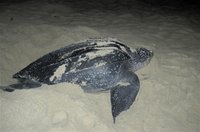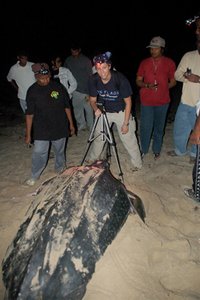For the environmental protection of the endangered leatherback sea turtle it is vital to gain better knowledge of its life history. Researchers from the Centrum Wiskunde & Informatica (CWI) in collaboration with biologists from Duke University (USA) and WIDECAST have developed an automated image recognition technique to identify individual specimens. Leatherbacks can be recognized by a cloudy looking pink spot - as unique as a fingerprint – on top of their heads. The novel technique allows for quick and effective comparison of thousands of pictures of these turtles. In the future, this technique will be incorporated into a global virtual marine map upon which leatherbacks can be identified and monitored.
Tracking leatherback turtles
A contemporary of the dinosaurs, the leatherback is the largest turtle species on earth. Temperate or warm seas and oceans are his primary habitat. It is estimated that between 34,000 – 94,000 adult leatherbacks exist in the North Atlantic Ocean today. Traditional methods for animal detection rely on the use of tags or transponders. Not only are these tracking methodologies costly and time consuming, but they also cause stress and discomfort to the animal. The development of non-invasive methods is preferable. The new technique, based on digital photography, is such a method. Photo-identification carries the advantages of wide application and minimal handling of the animal. During the nesting season, large groups of female leatherbacks come ashore on beaches to lay their eggs. At that time, biologists and volunteers record information regarding the physical health of the turtle and photograph the pink spots of as many leatherbacks as possible. Next, the images can be submitted to and processed by a computer.
Automatic Image Recognition
It is difficult for a computer to compare similar but not identical images. If the same turtle is photographed under different conditions and at different periods, there is variation in the image for instance caused by a different exposure and viewpoint, scars, or pollution. Initially, the algorithm selects the salient points (centers of small regions that stand out) in each separate frame. Next, the two images are compared based on the shapes of the constellations formed by these points. Additionally, these constellations provide a reference to compare further details of the images. This process has shown to be effective. Previously, CWI also developed an automated image recognition technique to match images of sperm whales but based on their unique tail profiles.
New trend: biodiversity observation
CWI's research is an example of a new development in ecology that focuses on automated observing of animals. Novel image analysis techniques allow for the acquisition of new knowledge about animals and their life histories. Since it is estimated that 40 percent of all plants and animals now living are threatened by extinction, new technologies are in demand to provide better opportunities to protect animals and take action against threatening factors.
More photo's:

Leatherback coming ashore on the beach

Danielle Buonantony (Duke University) photographing the pink spot of the leatherback
Source: Duke University
